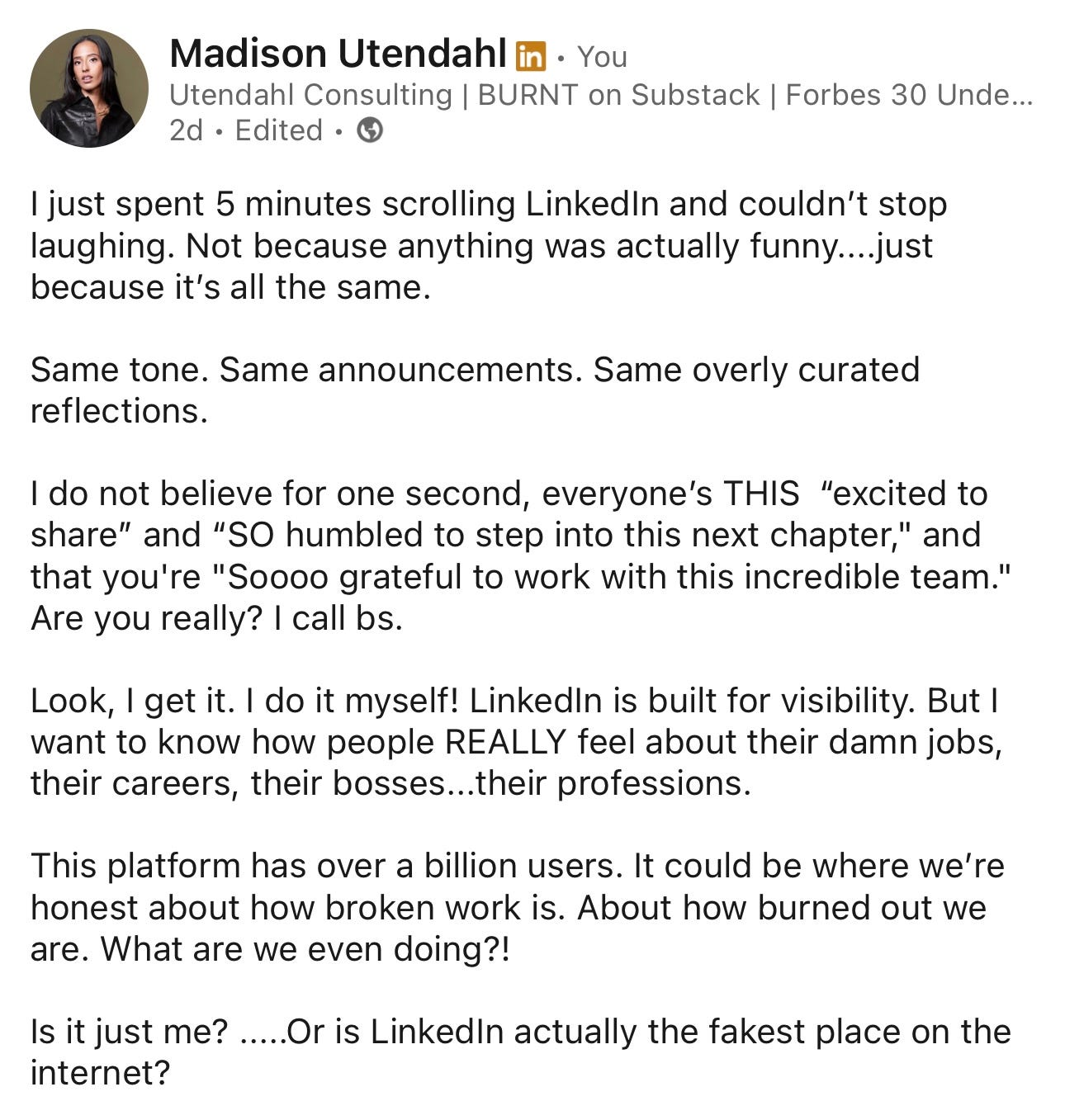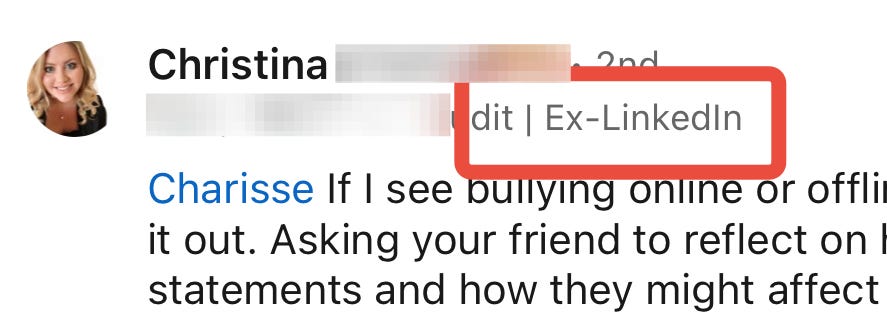LinkedIn Is Not That Serious (But Apparently It Is?!)
I called out the platform, and the reaction became the case study.
A few weeks ago, I wrote a post on LinkedIn, and turned it into a Substack titled “Is LinkedIn the fakest place on the internet?” It was a simple provocation that asked a real question: how much of what we post on LinkedIn is actually us, and how much of it is performance?
The piece resonated. Thousands of people shared it, commented, and DM’d me saying they’ve felt the same pressure to self-brand, self-edit, and self-optimize for a platform that mostly rewards corporate poetry and repackaged trauma. The article blew up. Messages of quiet solidarity poured in and I found myself elated with a newfound community of people who were also so tired of the pressure to keep performing their ambition…
But then, in true internet fashion, things got weird….
To promote the article, I posted an AI-generated LinkedIn post to Instagram. It was satire. Clearly. Obviously. Painfully.
Let’s Dissect:
"Enablemennt" is spelled wrong.
"InsightSphere" is not a real company.
"Director of Enterprise Optimization & Strategic Enablement" sounds like it was made up in a bad improv class.
Karen Glass is not a real person…In fact, that image is a bot.
This was not subtle. It was satire. A joke. An intentionally ridiculous AI-generated parody designed to highlight the empty corporate jargon that floods LinkedIn feeds every day. I made the Karen Glass Post on ChatGBT using their image generator.
And yet, while most people joined in on the fun…They were many who were weren’t laughing. They were outraged.
I started getting very angry and defensive DMs. People were offended.
The most surreal part? These weren’t people I knew. They were mostly strangers, all women. Women telling me that mocking this kind of post was unfair. That I was being harsh. That it wasn’t “that deep.”
I was equal parts amused and confused. If an obviously fake, AI-generated LinkedIn post “isn’t that deep,” why are you in my DMs?
And if critiquing a billion-user tech platform makes me the mean girl, what does that make the woman privately policing another woman’s tone?
The irony? Chef’s kiss.
The defensiveness? Loud.
And the story was just getting good.
But the bigger twist was still coming.
And I was locked in.
Where It All Began
Later on I found myself back on LinkedIn, my original post had over 100,000 impressions, 200 comments, countless DM’s and I simply couldn’t keep up. As I found myself scrolling through, reading them in total fascination, I noticed a comment from a woman named Christina. And it was fascinating. Juicy, even. Because it didn’t just prove my point, it performed it.
Christina had completely reframed the article as a personal attack on people who are “just trying.” As if what I wrote was a takedown of folks with less writing experience. As if I was mocking beginner vulnerability instead of interrogating a deeply toxic platform culture.
She centered her own discomfort in the critique.
She missed the point entirely.
She then did exactly what I was calling LinkedIn out for.
Lets pause here and set the record straight:
My commentary wasn’t aimed at “people trying to find their voice.” It was clearly aimed at the structure. The way LinkedIn rewards vague, jargon-filled, overly curated announcements while burying anything that sounds remotely human. The pressure to turn every hardship into a leadership lesson. The way we’re expected to optimize our personality for engagement.
But rather than engage with that nuance, Christina decided I needed a public lesson in kindness. Which would’ve been fine, if it wasn’t so ironic. Because what she really wanted was for me to make my critique more palatable. More polite. More LinkedIn-friendly. And that’s exactly the performance I was writing about!
Then Charisse entered the chat.
A total stranger. Not someone I prompted. Not someone I know. Just an individual who saw what was happening and decided to respond.
She wrote:
“I don’t know Madison. But she didn’t call anyone out. She offered a critique on a type of messaging. You, however, chose to call her a bully.”
It was measured. Calm. Correct.
But Christina, was not done, she replied again.
At this point, I had to laugh. What was Christina even talking about?
I went back and reread my original post, trying to trace the logic. But it was as if we weren’t even having the same conversation. She was fully in a world of her own, a world where questioning the tone of LinkedIn posts is an act of violence. Where a woman critiquing a platform becomes a bully. And she, the unsolicited morality police, is the hero!
I couldn’t help but wonder, was Christina defending others or just her own discomfort? Was the projection as obvious to everyone else as it was to me? And why was she going to bat for a group I hadn’t even called out? Nowhere in my post did I call out people “trying,” on LinkedIn.
But before I could answer those questions, in true internet fashion, the comments took care of themselves. More people jumped in, calling her out for missing the point entirely. I didn’t even have to respond.
She was outnumbered, and then she vanished.
Blocked us all.
Poof.
You Couldn’t Script It Better If You Tried
It was a perfect case study. Because buried in Christina’s outrage was the exact cultural script I was trying to deconstruct. She was so comfortable within LinkedIn’s culture, so at home in its tone and expectations, that she couldn’t recognize my critique as structural. It appeared as if she took my post so personally and without any awareness of the privilege that allows some people to feel safe in spaces that exhaust everyone else.
I loved all of it. Truly. It was so entertaining and mind-blowing. Considering I am someone who identifies as a so-called “digital anthropologist,” I found myself psychoanalyzing how this all could have so beautifully unfolded.
And then I realized, there was a minor…actually MAJOR, detail I had missed in her commentary….
Christina was a former LinkedIn Employee.
Of course she was.
Now to be clear, I don’t know Christina. I’m not here to make assumptions about her relationship to her former employer, or even her full feelings about my post, beyond what she chose to share publicly. But I do find it fascinating that one of the loudest voices defending LinkedIn… used to work at LinkedIn. It was all there: self-insertion, platform allegiance, and the urge to publicly perform “kindness” colliding in one beautifully ironic moment.
And that, in many ways, is the point of my entire body of work…This is what my Substack BURNT is all about.
We’ve been conditioned to see our workplaces as extensions of ourselves. Especially in the U.S., where employment is tied to worth, identity, even morality. So when someone critiques the system, it doesn’t just feel uncomfortable, it feels offensive. We confuse loyalty with integrity. We hear structural critique as personal attack. And instead of examining the system, we double down, defending it as if it ever truly defended us.
A Greater Message
This isn’t just about LinkedIn.
It’s about our collective inability to hold critique without making it personal. If we can’t question a platform without someone reframing it as a personal wound, how are we ever going to be able to critique systems that hold real power?…**Cough Cough** Our Government. Institutions. Leadership. Culture.
We must be able to hold personal pain and still recognize a larger narrative at play. We can feel defensive and still choose to stay in the conversation. LinkedIn could genuinely be a tool for connection, access, even transformation. But we’ve lost the plot. Somewhere along the way, the platform stopped being about possibility and started being about performance. Its American individualism at its finest.
So yes, it was just a post. And yes, it was just a critique of a platform that’s shifted so far, many of us barely recognize it. And yes, LinkedIn is not that deep.
But that’s not the point.
The point is, we have to keep poking holes in the performance.
Not just on LinkedIn, but everywhere.
Our jobs. Our platforms. Our systems. Our country.
Because when performance replaces truth, everything starts to rot beneath the surface. Critique isn’t cruelty. It’s necessary. It’s nuanced. We must continue to keep pissing off the Christinas of the world, one jargon-fueled, trauma-packaged, synergy-optimized post at a time.
This is bigger than LinkedIn.
It always was.
We must keep questioning.
We must keep challenging.
Because the cost of staying quiet isn’t just missed opportunities or awkward DMs.
It’s burnout.
It’s erasure.
It’s lives.
And if that makes someone uncomfortable?
Good.
Now if you’ll excuse me, it’s time to trigger another LinkedIn loyalist.
Disclaimer: Names have been partially anonymized. All references are drawn from material publicly posted by the individuals themselves. This piece constitutes commentary and analysis in accordance with Section 107 of the U.S. Copyright Act (Fair Use) 😘😘











Wow. I couldn't love this more. And when you wrote,
"Because when performance replaces truth, everything starts to rot beneath the surface. Critique isn’t cruelty. It’s necessary. It’s nuanced" it really resonated because I had a Boss like Christina who missed the mark constantly and subscribed to this superficial "yes" mentality and I experienced burnout as a byproduct. So thank you for laying this out so beautifully- we must keep questioning and we must keep challenging... 100% 👏👏👏👏 I 👏AM 👏HERE 👏FOR👏IT👏
LinkedIn is such a weird place… I recently followed so many other professionals in the social media marketing industry and I’m noticing so much of the content sounds the same, I’m comparing myself to the continual parade of successes, or everyone’s preaching with punchy one-liners. Also the algorithm itself still has kinks to work out- I’m always seeing posts from 2+ weeks ago. I know so many people get clients from LinkedIn, so I’m trying, but it feels dystopian.